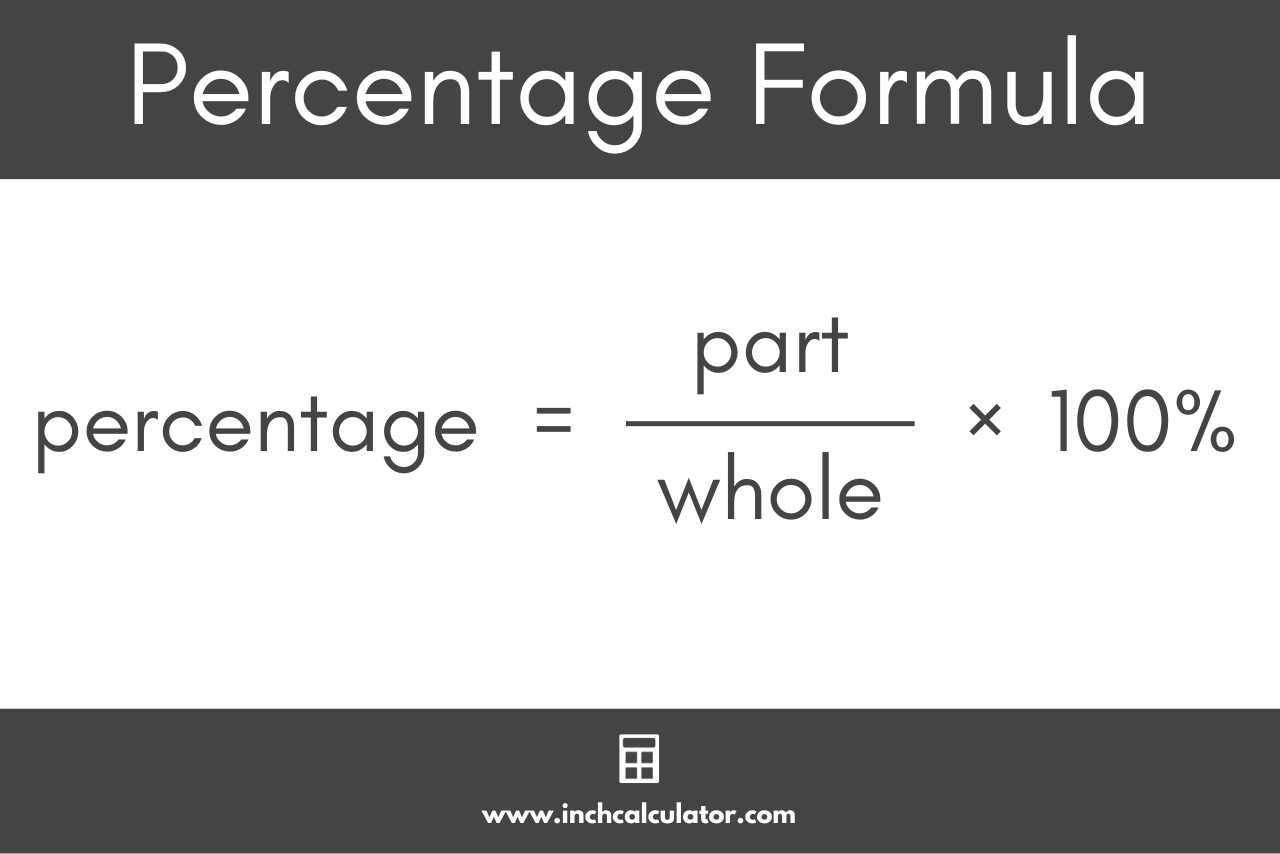Percentage Calculator
Use our percentage calculator to solve one of the problems below.
Select a Percentage Problem to Solve:
P Percent of X:
Steps to Solve
Steps to Solve
Steps to Solve
Steps to Solve
Steps to Solve
Steps to Solve
Steps to Solve
On this page:
- Percentage Calculator
- How to Calculate a Percentage
- How to Calculate the Percentage Between Two Numbers
- Percentage Formula
- How to Find the Percentage of a Number
- How to Find a Change in Value as a Percentage
- Percent Change Formula
- How to Calculate a Percent Increase
- How to Find the Percentage of Another Percentage
- Percent of a Percent Formula
- How to Convert Percentages
- How to Convert a Percent to a Decimal
- How to Convert a Percent to a Fraction
- How to Convert a Percent to a Ratio
- How to Convert Percentages to Basis Points
- Frequently Asked Questions
How to Calculate a Percentage
A percentage is the proportion of a partial amount to the whole amount and stands for “per 100.” It’s a ratio of one value to another that can be represented as a fraction over 100 or as a numerical value with a percent symbol (%). You may also see it denoted “pct” instead of the percent symbol.
Percentages are widely used beyond math class, for instance, to express or measure sales tax, discounts at the store, interest rates for loans, body fat, a tip at the restaurant, or the percent yield of a chemical reaction.
How to Calculate the Percentage Between Two Numbers
To start, let’s cover how to find the percentage between two numbers. For instance, you might want to find the number of correct answers on a test out of the total number of questions as a percentage to determine your grade.
Percentage Formula
To find a percentage between two numbers, use the following formula:
p = part / whole × 100%
Thus, the percentage is equal to the partial value divided by the whole amount, times 100%. Don’t forget to add “%” to the result.
For example, if you’re trying to find your results on a test, divide the number of correct answers by the total number of questions, then multiply the result by 100 to get the percentage of correct answers.

Example: What Percent is 25 Out of 50?
For example, let’s calculate the percentage of correct answers for a test where the student scored 25 out of a maximum of 50 possible correct answers by applying the formula above. The first value 25 is the partial amount and the second value 50 represents the whole.
p = 25 / 50 × 100%
p = 0.5 × 100%
p = 50%
So, 25 out of 50 is 50%. You can also use our marks percentage calculator to find the percentage of correct answers on tests like this.
How to Find the Percentage of a Number
In some cases, you might need to find the percentage of a number. Think of this as finding the partial value of the whole when given only the percent of the whole.
By using algebra to rewrite the percentage formula above, it’s possible to solve any of the values if the other two are known. So, to find the percentage of the part to the whole, use the following formula:
y = x × p / 100
The part y of the whole x is equal to the whole x times the percentage p, divided by 100.
Example: What is 25% of 80
Use the formula above to find 25% of 80.
y = 80 × 25 / 100
y = 2000 / 100
y = 20
So, 25% of 80 is 20.
How to Find a Change in Value as a Percentage
A change from one value to another is often expressed as a percentage; this is known as percent change. For instance, when an item at the store is marked on sale, it may be advertised as the “percent off” of the original price.
Percent Change Formula
You can find percent change using this formula:
p = y2 – y1 / |y1| × 100%
Percent change p is equal to the current value y2 minus the previous value y1, divided by the absolute value of the previous value y1, times 100%.
How to Calculate a Percent Increase
When talking about percent change, we’re really talking about the percent increase or the percent decrease from one value to another. If the resulting change is positive, then it’s a percentage increase; if it’s negative, then it’s a percentage decrease.
For instance, if you’re offered a pay raise, you likely want to know how much of a raise you’re getting, or rather, the increase in pay relative to your current pay. A $1 per hour raise for someone making $20 per hour is a much higher percentage increase than for someone making $30 per hour.
You can use the percent change formula above to calculate percent increase, or you can use a percent increase calculator. We have a percent decrease calculator as well!
Example: How to Find the Percent Increase Going From 20 to 25
For example, let’s find the percent increase in pay given a raise from $20 per hour to $25 per hour.
p = $25 – $20 / |$20| × 100%
p = $5 / $20 × 100%
p = 0.25 × 100%
p = 25%
Using the change formula above, you can find that a raise from $20 per hour to $25 per hour is a 25% increase in pay. Not too shabby!
How to Find the Percentage of Another Percentage
Occasionally, you may find the need to calculate the percentage of another percentage. For instance, let’s say you take a test that represents 10% of the grade in a class; if you score 80% on the test, how much does that one score contribute to your overall grade?
Percent of a Percent Formula
To find the percent of a percent, use the following formula:
p = p1 / 100 × p2 / 100 × 100%
The percentage of a percentage p is equal to the first percentage p1 divided by 100 times the second percentage p2 divided by 100, times 100%.
Example: How to Find 20% of 50%
Let’s apply this to an example and find 20% of 50%.
p = 20% / 100 × 50% / 100 × 100%
p = 0.2 × 0.5 × 100%
p = 10%
So, 20% of 50% is equal to 10%.
How to Convert Percentages
We mentioned above that a percentage is a proportion of a partial value to the whole that can be represented as a fraction over 100 or as a numerical value with a percent symbol. So far, we’ve been expressing the result as a numerical value with the “%” symbol, but as mentioned, you can also express a percentage as a fraction.
In fact, you can also represent a percentage as a decimal or ratio as well.
How to Convert a Percent to a Decimal
As mentioned above, percent means “per 100,” so to convert it to a decimal, you can simply divide the percent by 100.
So, the percent to decimal conversion formula is:
decimal = p ÷ 100
The decimal value is equal to the percentage p divided by 100.
Example: Express 50% as a Decimal
Let’s express 50% as a decimal.
50% = 50 ÷ 100
50% = 0.5
So, the decimal equivalent of 50% is 0.5.
Learn more using our percent to decimal calculator.
How to Convert a Percent to a Fraction
Since a percentage is a measurement “per 100,” you can also express a percent as a fraction by placing it in fraction form over 100.
fraction = p / 100
The fraction is equal to the percentage p over 100. After placing it over 100, you can then reduce the fraction to its simplest form.
Example: Express 50% as a Fraction
Let’s express 50% as a fraction.
50% = 50 / 100
Then simplify.
50 / 100 = 1 / 2
So, 50% is equivalent to 1 / 2 in fraction form.
Learn more using our percent to fraction calculator.
How to Convert a Percent to a Ratio
Since a percentage is really just a ratio of a partial value to the whole, you can also represent it in ratio form. To express a percent in ratio form, first convert it to fraction form, then simply replace the fraction bar with a colon (:).
Example: Express 50% as a Ratio
Let’s express 50% as a ratio. We already know that 50% is equivalent to 1 / 2 in fraction form.
50% = 1 / 2
50% = 1:2
So, 50% is equivalent to 1:2 in ratio form.
Learn more using our percent to ratio calculator.
How to Convert Percentages to Basis Points
Basis points represent a fraction of a percentage. One basis point is equal to 0.01%, so to convert percentages to basis points, you can multiply the value by 100.
basis points = percentage × 100
Example: Express 0.25% in Basis Points
Let’s express 0.25% in basis points.
0.25% × 100 = 25 bps
So, 0.25% is equivalent to 25 basis points.
Frequently Asked Questions
What is a percent in math?
A percent in math is a value indicating a hundredth part of a quantity. 1% is one hundredth of a whole part.
Why do we calculate percentages?
We calculate percentages so because it is easier to find parts of 100.
How do you find a percentage?
To calculate a percentage, you divide the part by the whole and then multiply by 100.


